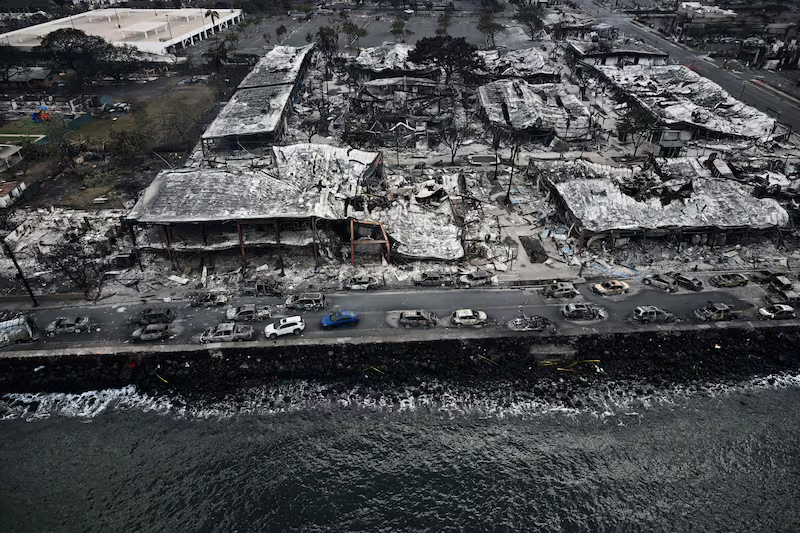Maui residents who escaped a wildfire that killed at least 55 people have asked why Hawaii’s emergency sirens did not alert them as the flames raced toward their homes.
Hawaii emergency management records show no indication that the warning system was triggered before a devastating wildfire wiped out the historic town of Lahaina, officials confirmed.
Hawaii boasts what the state describes as the largest single outdoor all-hazard public safety warning system in the world, with about 400 sirens positioned across the island chain.
But many of Lahaina’s survivors said they did not hear any sirens and only realised they were in danger when they saw flames or heard explosions nearby. The wildfires are the state’s deadliest natural disaster since a 1960 tsunami killed 61 people.
READ MORE
An even deadlier tsunami in 1946, which killed more than 150 people on the Big Island, prompted the development of the territory-wide emergency system that includes the sirens, which are sounded monthly to test their readiness.
Thomas Leonard, a 70-year-old retired postal worker from Lahaina, did not know about the fire until he smelled smoke. Power and mobile phone service had both gone out earlier that day, leaving the town with no real-time information about the danger.
Leonard tried to leave in his Jeep, but had to abandon the vehicle and run to the shore when cars nearby began exploding. He hid behind a sea wall for hours, the wind blowing hot ash and cinders over him.
Firefighters eventually arrived and escorted him and other survivors through the flames to safety.
Hawaii Emergency Management Agency spokesman Adam Weintraub said the department’s records did not show that Maui’s warning sirens were triggered on Tuesday. Instead, the county used emergency alerts sent to mobile phones, televisions and radio stations, Weintraub said.
It is not clear if those alerts were sent before widespread power and phone coverage outages cut off most communication to Lahaina.
Fuelled by a dry summer and strong winds from a passing hurricane, the fire started on Tuesday and took Maui by surprise, racing through parched brush covering the island and then flattening homes and anything else that lay in its path.
Governor Josh Green said the death toll would likely rise further as search and rescue operations continued. “Lahaina, with a few rare exceptions, has been burned down,” Green said after walking the ruins of the town with Maui Mayor Richard Bissen.
“Without a doubt, it feels like a bomb was dropped on Lahaina.”
The fire is the deadliest US wildfire since the 2018 Camp Fire in California, which killed at least 85 people and laid waste to the town of Paradise.
Lahaina’s wildfire risk was well known. Maui County’s hazard mitigation plan, last updated in 2020, identified Lahaina and other West Maui communities as having frequent wildfire ignitions and a large number of buildings at risk of wildfire damage.
West Maui was also identified as having the island’s highest population of people living in multi-unit housing, the second-highest rate of households without a vehicle, and the highest rate of non-English speakers.
“This may limit the population’s ability to receive, understand and take expedient action during hazard events,” the plan noted.
Maui’s firefighting efforts may also have been hampered by a small staff, said Bobby Lee, the president of the Hawaii Firefighters Association.
There were a maximum of 65 firefighters working at any given time in Maui County, and they were responsible for fighting fires on three islands – Maui, Molokai and Lanai – he said.

Those crews had about 13 fire engines and two ladder trucks, but they were all designed for on-road use. The department did not have any off-road vehicles, Lee added.
That meant fire crews could not attack brush fires thoroughly before they reached roads or populated areas. The high winds caused by Hurricane Dora made that extremely difficult, Lee said.
“You’re basically dealing with trying to fight a blowtorch.You’ve got to be careful – you don’t want to get caught downwind from that, because you’re going to get run over in a wind-driven fire of that magnitude,” he added.
Mandatory evacuation orders were in place for Lahaina residents, Bissen noted, while tourists in hotels were told to shelter in place so that emergency vehicles could get into the area.
The mayor said that downed power poles added to the chaos as people attempted to flee Lahaina by cutting off two important roads of town. Speaking at a Thursday afternoon press conference, he said that 29 poles fell with live wires still attached, cutting off the roads to Wailuku and the airport and leaving only the narrow highway toward Kahakuloa.
Communications have been spotty on the island, with emergency, landline and mobile phone service failing at times. Power was also out in parts of Maui.
Tourists were advised to stay away, and about 11,000 flew out of Maui on Wednesday with at least 1,500 more were expected to leave on Thursday, according to Ed Sniffen, state transportation director.
Officials turned the Hawaii Convention Centre in Honolulu into an assistance centre for tourists and locals, stocking it with water, food, and volunteers who help visitors arrange travel home. – AP













